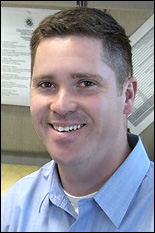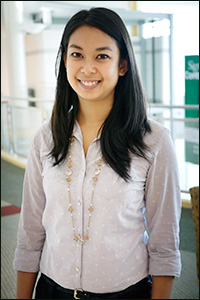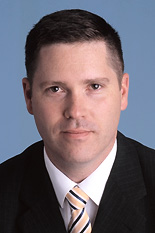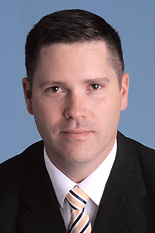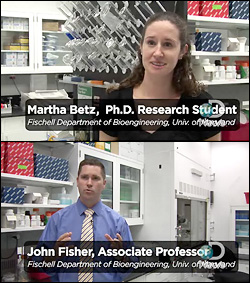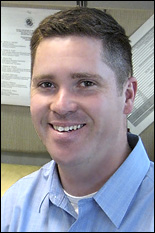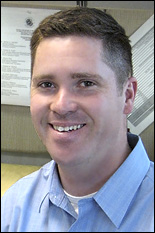News Story
A Better Way to Heal Broken Bones
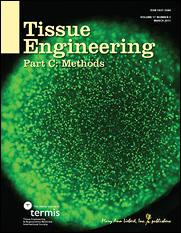
Professor John Fisher and graduate student Andrew Yeatts' research on the cover of Tissue Engineering Part C: Methods. The image shows a fluorescing live/dead image of human mesenchymal stem cells cultured in an alginate bead that forms part of a new bioreactor used to grow replacement bone and tissue.
A paper about the device, "Tubular Perfusion System for the Long Term Dynamic Culture of Human Mesenchymal Stem Cells," by BioE graduate student Andrew Yeatts and his advisor, Associate Professor John Fisher, was recently featured on the cover Tissue Engineering Part C: Methods.
In 2009, Fisher and Yeatts were part of a team that won the Best Inventor Pitch at the university's annual Professor Venture Fair for its design of a patent-pending tissue engineering bioreactor system that grows bone and other types of tissue for implantation. Their bioreactor makes tissue engineering more efficient by reducing cost and complexity while increasing the amount of nutrients the cells inside receive, resulting in a more prolific culture. The system is easy to set up and customize, and can be assembled from off-the-shelf components.
Although many tissue and bone injuries heal naturally, large or catastrophic injuries, or those in delicate areas such as the face, often require surgery, bone grafts, or artificial implants in order to reconstruct what has been lost. The results are often less than ideal, both physically and cosmetically.
Fisher's group is designing tissue engineering solutions that quickly grow the patient's own stem cells in the lab in a special biocompatible material, an alginate hydrogel called a scaffold. The cells are then transplanted back into the body at the injury site, where they literally fill in the gaps and repair the damage. The bioreactor provides a protective environment for the cell-filled scaffolds that encourages growth.
The recent publication, Yeatts explains, covers the next stage in the device's development. "Previously, we developed a bioreactor, the tubular perfusion system (TPS), that utilizes a unique design in which nutrient-rich media is pumped through tightly packed beads of alginate scaffolds," he says. "The new study evaluates how cells respond to it."
Fisher and Yeatts loaded the TPS with scaffold beads containing human mesenchymal stem cells, which are found in bone marrow and are capable of differentiating into many kinds of tissues, including bone and cartilage. The pair then observed their growth and noted whether they became bone cells called osteoblasts.
"We were excited to discover that not only did the stem cells grow faster in the bioreactor, they more effectively differentiated into osteoblasts," says Yeatts. "We were able to show this by analyzing typical genetic markers of osteoblastic differentiation as well as observing the amount of calcium, a key extracellular matrix component in bone, that was deposited by the cells."
Yeatts says he and Fisher are currently working toward making their bioreactor available in clinical settings. "We hope to complete an in vivo study to demonstrate the system's effectiveness," he says, "and then work on gaining FDA approval. We really want to provide doctors with a better way to treat devastating bone injuries."
For More Information:
AB Yeatts and JP Fisher. "Tubular Perfusion System for the Long Term Dynamic Culture of Human Mesenchymal Stem Cells." Tissue Engineering Part C, Methods. 17: 337-348 (2011) Abstract »
Visit Professor Fisher's Tissue Engineering & Biomaterials Laboratory web site »
Published March 17, 2011

